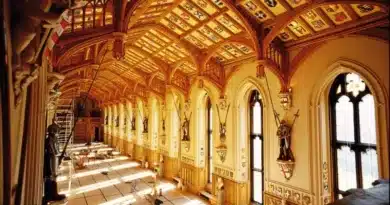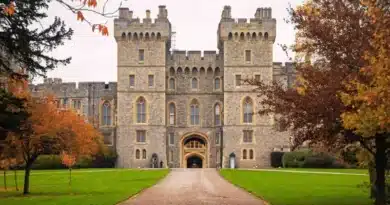The Old Court Arts Centre, Windsor’s History & Today
Key Takeaways
- Historical Transformation:
The Old Court Arts Centre has evolved from its origins as a magistrates’ court, police station, and fire station in 1905 into a vibrant arts and cultural hub. Designed by Henry Tanner, the building originally embodied civic pride with its neo-classical architecture. - Civic Past (1905-1966):
- Multi-functional Building: Served as Windsor’s centre for law enforcement, firefighting, and judicial proceedings for over six decades.
- Cinematic History: Briefly featured in the 1963 British film The Scarlet Blade.
- Transition Period: By the mid-1960s, the building was vacated, paving the way for its reimagining.
- Rebirth as an Arts Centre:
- Community Efforts (1966-1984): Led by the Windsor & Eton Arts Centre Association, local residents raised funds, secured council support, and undertook renovations to transform the space.
- Renovation Highlights: Courtrooms became performance spaces, the police cells were repurposed, and even the fire station’s hose tower found new use.
- Opening in 1984: Marked by a rich programme of theatre, music, film, and visual arts.
- Diverse Programming:
- Music: Includes classical concerts, jazz, folk, and rock performances.
- Theatre: Hosts local and professional productions, children’s theatre, and touring acts.
- Comedy: Features stand-up from renowned and emerging comedians.
- Film: Showcases independent and international films, with annual festivals.
- Visual Arts: The Attic Gallery exhibits works by local artists, with workshops for community engagement.
- Educational and Social Impact:
- Workshops for Youth: Theatre, music, and visual arts programmes nurture creativity and life skills in young people.
- Community Outreach: Collaborations with schools and social care organisations promote inclusivity and access to the arts.
- Addressing Social Issues: Through thought-provoking productions and events, the centre fosters dialogue on mental health, sustainability, and justice.
- Modern Legacy (2000-Present):
Today, The Old Court Arts Centre thrives as a cornerstone of Windsor’s cultural landscape, embracing its historical roots while fostering artistic innovation and community engagement.
By preserving its historical character and expanding its cultural offerings, The Old Court embodies a unique blend of Windsor’s heritage and contemporary creativity.
I. Introduction
The Old Court Arts Centre in Windsor has transformed remarkably from law courts to laughter. Once a symbol of civic duty, it now pulsates with artistic expression. This article explores its fascinating history, diverse programming, and impact on the community, showcasing its enduring legacy as a vibrant hub for creativity. Buckle up – let’s delve into the world of theatre, music, film, and visual arts, all within the walls of this historic building!
II. Windsor’s Cultural Landscape and the Birth of a Need
Windsor, nestled amidst the verdant Thames Valley, boasts a rich cultural tapestry woven over centuries. The town has long nurtured a vibrant artistic spirit, from the majestic Windsor Castle, a royal residence for over 950 years, to the bustling Eton College, a renowned educational institution. Yet, in the early 20th century, a gap existed in Windsor’s cultural landscape – a dedicated space for performing and visual arts was absent. This void catalysed the remarkable journey of The Old Court Arts Centre, a building reborn from its historic past to become a thriving hub for artistic expression.
A. Windsor’s Cultural Landscape:
Throughout the 19th and early 20th centuries, Windsor witnessed a burgeoning interest in the arts. Local amateur dramatic societies flourished, staging productions in makeshift venues. Music filled the airwaves with the establishment of the Windsor & Eton Choral Society in 1885. Art exhibitions found temporary homes in various halls and galleries, fostering an appreciation for visual arts. However, the lack of a permanent, dedicated space limited the scope and accessibility of these artistic endeavours.
B. From Civic Duty to Artistic Expression: (1905-1966)

The story of The Old Court Arts Centre began in 1905 with the construction a grand edifice on Victoria Street. Designed by esteemed architect Henry Tanner, the building embodied the civic pride of the era. Its imposing neo-classical facade, adorned with decorative brickwork and arched windows, housed not just one but three crucial public services:
- The Magistrates’ Court: Upholding law and order, the court saw countless cases tried within its imposing walls.
- The Police Station: Serving the community, the station was a hub for local law enforcement.
- The Fire Station: Ensuring safety, the fire brigade held their headquarters within the building, ready to respond to emergencies.
The building faithfully served its civic duties for six decades, witnessing Windsor’s changing tides. In the 1950s, however, whispers of its future repurposing began circulating. The decline in crime and advancements in fire safety rendered the court and fire station redundant. The police station also relocated, leaving the once bustling building eerily quiet.
1. The Magistrates’ Court, Police Station, and Fire Station:
- The magistrates’ court played a vital role in upholding Windsor’s law and order by presiding over petty crimes and minor offences. It served as a cornerstone of justice and community safety.
- The police station, a hive of activity, housed local constables who patrolled the streets and ensured public safety.
- The fire station, equipped with fire tenders in its early years (specific details of horse-drawn tenders are unconfirmed but likely), transitioned to modern fire engines later. These three vital services, housed within the same building, were integral to Windsor’s daily life for over half a century.
2. Lights, Camera, Action!:
Though primarily serving civic functions, the building had a brief brush with cinematic fame in the 1960s. In 1963, it served as the location for the British film “The Scarlet Blade,” starring Oliver Reed and Lionel Jeffries. The courtrooms and police station transformed into film sets, echoing the director’s commands and the actors’ lines. This brief foray into the world of cinema added a unique chapter to the building’s history, showcasing its adaptability and potential beyond its official duties.
3. A Period of Transition:
By the mid-1960s, the building’s original purpose had waned. With the relocation of the remaining services, it stood vacant, a silent sentinel on Victoria Street. Its future remained uncertain, with demolition a looming possibility. However, a passionate group of local residents saw its potential for a different kind of service – a space dedicated to nurturing the arts. This marked the beginning of a new chapter, where the building would shed its civic duty and embrace artistic expression.
III. Rebirth and Transformation: (1966-Present)

A. Community Spirit Ignites:
The closure of the civic services within the building sparked a fervent campaign to repurpose it for the arts. Spearheaded by the Windsor & Eton Arts Centre Association, a dedicated group of residents championed the vision of a vibrant arts centre open to all. Public meetings, fundraising initiatives, and passionate pleas to the local council fueled the movement. Notable figures like actor Christopher Reeve, a resident of Windsor at the time, lent their voices to the cause.
1. The Windsor & Eton Arts Centre Association:
Founded in 1966, the Windsor & Eton Arts Centre Association, led by Chairman John Waterman and Honorary Secretary Pamela DeNormandie, proved instrumental in the building’s transformation. Through tireless campaigning, fundraising events, and negotiations with the local council, they secured the building’s future as a dedicated art space. Their unwavering dedication and belief in the power of the arts laid the foundation for The Old Court Arts Centre’s success.
2. Fundraising and Negotiations:
Securing the building required more than passionate pleas. The Association embarked on a fundraising campaign, organising art exhibitions, concerts, and community events to raise awareness and crucial funds. Negotiations with the Royal Borough of Windsor & Maidenhead, owner of the building, were complex, requiring meticulous planning and persuasive arguments. Finally, in 1974, a lease agreement was secured, marking a triumphant moment for the Association and the future of the arts centre.
B. Renovations and Reopening (1981-1984)
Transforming the vision into reality demanded extensive work. Bustling courtrooms and police stations shed their past lives, morphing into performance spaces, workshops, and exhibition galleries. Architects meticulously designed the renovations, carefully preserving the building’s original character. For instance, the grand courtroom’s imposing oak benches and stained glass windows remained silent witnesses to its former purpose. Meanwhile, fundraising continued, fueled by the generous contributions of local businesses and individuals, all committed to this shared dream.
1. Transforming Spaces:
The courtrooms were reimagined as an auditorium, with a flexible stage and comfortable seating for over 200 patrons. The police station cells morphed into intimate performance spaces, perfect for smaller productions and workshops. Even the fire station’s hose tower found a new life, becoming a unique viewing platform overlooking the auditorium. Every corner of the building was imbued with a new purpose, fostering artistic expression and community engagement.
2. Overcoming Challenges:
The renovation process was challenging. Unexpected structural issues surfaced, and costs inevitably escalated. Yet, the Association’s unwavering dedication and the community’s continued support ensured the project’s completion. Local volunteers offered their time and skills, contributing to the building’s transformation. This collective effort solidified the community’s ownership and investment in the future of their art centre.
C. The Early Years and Establishing a Vision (1984-2000)
In 1984, The Old Court Arts Centre finally opened its doors to the public, marking a momentous occasion for Windsor. The inaugural season offered a diverse theatre, music, dance, and film program, captivating audiences and establishing the centre as a vital cultural hub.
1. Fostering Local Talent and Bringing in Big Names
From the outset, The Old Court Arts Centre embraced a two-pronged approach: nurturing local talent and attracting established artists. Local amateur dramatic societies, choirs, and dance groups found a welcoming platform to showcase their work. Meanwhile, renowned performers like jazz musician John Dankworth and classical guitarist Julian Bream graced the stage, bringing national and international acclaim to the fledgling arts centre.
2. Diversifying the Programming
Beyond performance arts, The Old Court embraced visual arts. The Attic Gallery, inaugurated in 1988, provided a platform for local and regional artists to exhibit their work. Workshops and educational programs catered to all ages and interests, fostering community love for the arts. This diverse programming established The Old Court Arts Centre as a true multi-arts space, offering something for everyone.
3. Facing Challenges and Building Resilience
The early years also presented challenges. Financial constraints and competition from larger venues demanded constant innovation and fundraising efforts. However, the dedicated staff, led by the first manager, John Cooper, navigated these challenges with resilience and resourcefulness. The unwavering support of the community, evidenced by enthusiastic audiences and volunteer contributions, ensured the arts centre’s survival and growth.
IV. Exploring The Old Court Today (2000-Present)

A. The Current Programming
Today, The Old Court Arts Centre thrives as a vibrant testament to its founders’ vision. Its diverse programming caters to various tastes and age groups, solidifying its position as a cornerstone of Windsor’s cultural landscape.
1. Music:
Music fills the air within the auditorium, echoing through the grand space. The Old Court Orchestra, a resident ensemble, presents classical concerts yearly while visiting chamber groups and soloists offer international flair. The auditorium transforms from jazz improvisation to folk music evenings to cater to all musical tastes. Rock and pop music finds its home in the intimate Fire Station Studio, hosting rising stars and established bands, captivating audiences with electrifying performances.
2. Theatre:
The auditorium transforms into a world of imagination, hosting a range of theatrical productions. Local amateur troupes stage heartfelt comedies and gripping dramas, showcasing the community’s creative talent. Professional touring companies bring award-winning productions to Windsor, ensuring exposure to renowned actors and contemporary plays. Children’s theatre productions spark young imaginations, fostering a love for the arts from a young age.
3. Comedy:
Laughter mingles with applause as stand-up comedians take centre stage. From established names on national tours to rising stars honing their craft, the auditorium reverberates with the joy of laughter. Comedy nights provide a platform for local talent, showcasing the wit and humour of the community. These lighthearted evenings offer a welcome escape from daily routines, bringing communities together through shared laughter.
4. Film:
The magic of cinema comes alive within the auditorium. Independent films, documentaries, and foreign language features find their audience on the big screen, offering diverse perspectives and enriching cultural understanding. Film festivals throughout the year celebrate specific genres or themes, attracting film enthusiasts from across the region. With its dedicated membership, the Old Court Film Society ensures a steady stream of thought-provoking and critically acclaimed films, fostering discussions and appreciation for the art of cinema.
5. Visual Arts:
The Attic Gallery continues to be a platform for showcasing local and regional artists’ work. Regularly changing exhibitions present diverse mediums, from contemporary paintings and sculptures to photography and textiles. Interactive workshops led by experienced artists invite participants of all ages to explore their own creativity and develop their artistic skills.
B. Education, Community Engagement, and Social Impact

The Old Court Arts Centre’s impact extends beyond the stage. Educational programs engage young minds, inspiring future generations of artists and audiences. School workshops introduce children to theatre, music, and visual arts, nurturing their talents and sparking a lifelong love for the arts. Outreach programs bring arts experiences to marginalised communities, promoting inclusivity and social engagement. Collaborations with local schools and organisations further widen the arts centre’s reach, enriching the lives of diverse audiences.
1. Educational Programs and Workshops
The Old Court Arts Centre actively fosters artistic development in young people. Theatre workshops allow children to explore storytelling, improvisation, and character development, building confidence and communication skills. Music workshops introduce various instruments and musical styles, encouraging creativity and teamwork. These educational programs equip young people with artistic skills and instil valuable life lessons and a lifelong appreciation for the arts.
2. Collaborations and Partnerships
The Old Court Arts Centre recognises the power of collaboration in strengthening the community and amplifying its impact. Partnerships with local organisations, such as schools, libraries, and museums, offer joint programs and events, reaching wider audiences and fostering inclusivity. Collaborations with social care institutions bring arts experiences to underserved communities, promoting well-being and social connectedness. These partnerships demonstrate the arts centre’s commitment to serving the community beyond its physical walls.
3. Addressing Community Issues Through Art
The Old Court Arts Centre recognises the potential of art to address social issues and spark dialogue. Theatre productions and film screenings tackle contemporary themes such as mental health, sustainability, and social justice, encouraging critical thinking and community engagement. Educational workshops raise awareness about environmental issues and cultural diversity, empowering individuals to be agents of change. The Old Court Arts Centre tackles crucial societal issues through artistic expression, using its platform to promote understanding and inspire positive action.
Website: https://oldcourt.org/
V. Conclusion
The Old Court Arts Centre is more than just bricks and mortar; it’s a testament to the enduring power of creativity. Its walls resonate with countless stories, from its days upholding civic duty to its vibrant present as a hub for artistic expression. The dedication of its founders, the unwavering support of the community, and the resilience of its staff have woven a legacy that enriches the lives of all who experience it.
This isn’t just a building; it’s a vital community hub. The Old Court fosters artistic talents, ignites cultural appreciation, and provides a platform for social engagement. Diverse programming and educational initiatives ensure that the arts are accessible to all, regardless of background or ability. This commitment to inclusivity strengthens the community’s social fabric and fosters a sense of belonging.
The Old Court doesn’t shy away from the future. Challenges like technological advancements and outreach expansion beckon, along with the need for sustainable funding. But with its unwavering commitment to its mission and the community’s continued support, it stands as a beacon of creativity. The Old Court reminds us of the power of art to uplift, inspire, and connect, ensuring that its spirit of creativity thrives within its walls for generations to come.
VI. FAQ
What architectural features of The Old Court reflect its original civic purpose?
The Old Court’s neo-classical facade, arched windows, and decorative brickwork convey its original civic purpose, embodying early 20th-century pride in public institutions.
Why was the building chosen for the 1963 film The Scarlet Blade?
Its preserved courtrooms and police station offered authentic period settings ideal for the historical drama, showcasing its adaptability.
How did the local council initially respond to proposals for an arts centre?
The council initially hesitated but was persuaded by public support and the efforts of the Windsor & Eton Arts Centre Association.
What was the most challenging aspect of the 1981-1984 renovations?
Unexpected structural issues and escalating costs tested the resilience and resourcefulness of the community and project leaders.
Are there any artefacts or remnants from the building’s civic past still visible today?
Yes, features like oak benches and stained glass windows in the grand courtroom remain intact, linking the present to its civic history.
How does The Old Court engage older audiences?
The centre offers classical concerts, workshops tailored to retirees, and heritage events celebrating Windsor’s history.
What unique uses has the former fire station’s hose tower been repurposed for?
It now serves as a viewing platform and occasionally hosts art installations, blending history with modern creativity.
How does The Old Court support local artists?
The Attic Gallery regularly exhibits local artwork, while workshops and residencies provide opportunities for skill development and exposure.
What accessibility features does The Old Court offer for differently-abled visitors?
The venue has wheelchair access, hearing loop systems, and sensory-friendly events to ensure inclusivity.
What role does The Old Court play in fostering sustainability?
The centre promotes sustainability through green building practices, educational workshops on environmental issues, and hosting eco-conscious events.









